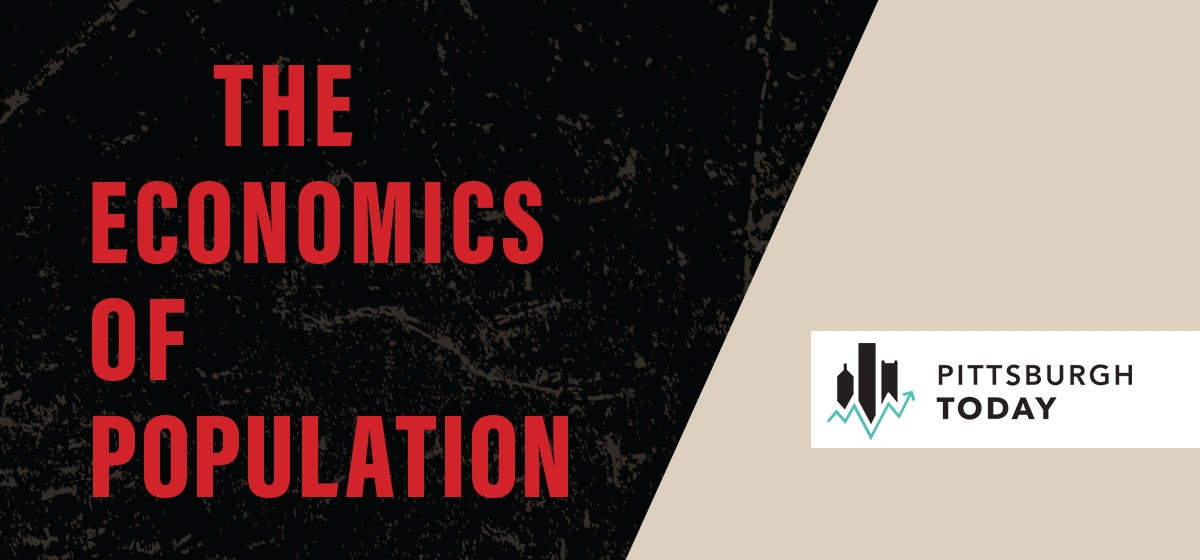
Last spring, the U.S. Census Bureau released data showing that the City of Pittsburgh and Allegheny County once again lost population. In what has become a ritual, public officials were pressed by reporters to respond. County Executive Rich Fitzgerald suggested not reading too much into the latest of a long string of down years. Pittsburgh Mayor Bill Peduto didn’t back off his goal of adding 20,000 city residents by 2025. Both dismissed the idea that another year of population loss is a warning that the city and the region’s largest county face a grim future.
Population growth long has been a popular barometer of whether a city or region is succeeding, stagnating or failing. More people fuel the economy in a number of ways, making for a more vibrant place and a healthier long-term outlook, the argument goes. But the relationship between population, a region’s economy and the well-being of its citizens is complicated.
No major U.S. metropolitan region has lost more people since the 1960s than Pittsburgh. Few have endured an economic calamity as severe as the collapse of its steel industry. Yet, the per capita wealth in Pittsburgh is higher and several indicators of quality of life are better in southwestern Pennsylvania than in most of the metro areas that have passed it in population.
“We are unique, in a way, because we still are a pretty dynamic and vibrant region,” said Vera Krekanova, chief research officer at the Allegheny Conference on Community Development, a nonprofit economic development organization covering southwestern Pennsylvania. “But we are one of the few large metro areas that aren’t growing and the data raise concern.”
The allure of growth
Population growth doesn’t guarantee economic health, but it does influence conditions and perceptions that promote it.
About 70 percent of a regional economy is made up of providing goods and services to the local population. The more people a region has, the larger the market to support local businesses and others, such as museums, theaters and other cultural amenities that raise the quality of life.
Places with a growing population provide a deeper pool of prime-working-age adults for businesses to hire than regions hemorrhaging people. Southwestern Pennsylvania is on the wrong end of those numbers, but it has plenty of company. Nearly 80 percent of U.S. counties lost people ages 25 to 54 over the last decade, a Moody’s analysis suggests. The losses have been felt in urban, suburban and rural counties, although the majority of the counties affected are outside of urban centers. Northeastern, mid-Atlantic and midwestern states have been hit the hardest. And in five northeastern states—Vermont, Maine, Connecticut, Rhode Island and New Hampshire—prime working age population declined in every county.
More people means greater demand for housing. However, chronic population loss leads to weak demand and lower housing values, which discourages property owners from spending on other things. For every $100 drop in housing value, property owners spend $5-$10 less on average, a study by Princeton University and University of Chicago researchers found.
The tax burden of paying for public infrastructure and services is also affected. A growing population broadens the tax base, allowing for a larger source of public revenue with the costs shared among a larger group of residents. Shrinking populations stress municipalities. They see their revenues dry up faster than their costs, most of which are fixed, such as maintaining roads and other infrastructure built for a larger population and the pensions and benefits of a workforce that bloomed in an era of greater economic vitality. Population loss can also lower county credit ratings, increasing how much they have to pay to borrow money.
As population is a basis for drawing political districts, such as seats in the U.S. Congress, it affects the influence cities and counties have with federal and state governments, including the ability to leverage funding for capital projects and services.
And whether population is growing or shrinking shapes perceptions. Growth tends to catch the eye of expansion-minded businesses. Places bleeding residents and workers give them pause.
“Companies looking for a location to put a new facility will limit themselves to the top 25 markets in the country,” said James Futrell, vice president of market research and analysis at the Pittsburgh Regional Alliance. “We were the 18th largest metro region in the country in 2000. We are now 27th. Businesses that want to grow see our data. We’re one of the metros that are declining. They might not understand what the reasons are or the demographic challenge of the steel collapse. The message is, something horrible is wrong with Pittsburgh. We are not as large and we’re not growing, (and growth) is associated with vibrancy and health.”
Even the region’s high-profile recovery from the economic trauma it suffered several decades ago hasn’t put such perceptions to rest.
“There are a lot of interdependencies in the economy we are in. Growth is everything. If you don’t grow, you’re losing out,” Krekanova said. “But for us, it’s not growth for the sake of growth. It is more about vitality. How do we continue to prosper so the people, businesses and place can prosper?”
A different view
The region has lost more than 14 percent of its population since 1969. But what has happened since the collapse of the region’s dominant industry suggests that population growth as an indicator of economic health and quality of life can paint a misleading picture.
Today, the strengths of the region’s economy lie in prospering and promising industries, such as health care, artificial intelligence, robotics, life sciences, education and energy. They rose from the ashes of industrial decline to create a strikingly diverse economy in a region that had largely relied on the fortunes of manufacturing. The recovery has been widely heralded, never more than when Pittsburgh hosted the 2009 G20 summit and became the darling of the worldwide news media for its economic rebound, environmental progress, and the richness of its arts and culture. The region also weathered the “Great Recession” better than most others a decade ago. Its overall crime rate is among the lowest among metro areas. And top rankings in national “best places” polls has become an expectation rather than an exception.
Jobs are being created, but at a tepid pace compared to most other metro regions. The workforce, heavy with older workers, struggles to grow. And the region continues to lose a few thousand more people to other places in the U.S. than it gains each year.
But, by and large, people in the region like the quality of life it offers. More than 68 percent of Allegheny County residents rate the quality of life “excellent” or “very good,” while less than 1 percent describe it as poor, according to a quality of life survey done by Pittsburgh Today and the University of Pittsburgh last year.
“A region like Pittsburgh doesn’t always have to be growing to be a nice place to live,” said Paul Flora, manager of regional economic analysis at the Federal Reserve Bank of Philadelphia. He argues that using population and job growth as measures of economic health misses the point. More than numbers, it’s the type and characteristics of jobs in the region that matter.
When per capita income is adjusted to reflect the buying power people have in their region, the Pittsburgh MSA more than holds its own. Of the 17 regions that have leap-frogged Pittsburgh in population since 1969, only Minneapolis, St. Louis and Seattle have higher real per capita income. And only four have lower poverty rates. In Las Vegas, where population has grown at an estimated 4.5 percent a year since 1969, a tourism industry that doesn’t pay very high wages dominates the economy. In Pittsburgh, key job sectors include health care, technology and energy that pay higher wages.
“It’s not about size,” Flora said. “It’s more about the makeup of the industries, the mix, and more importantly, how progressive and productive the firms are. If they’re successful, you’re golden.”
Reasons for the region’s resiliency include early air pollution regulations, flood control and periods of downtown renaissance that helped create conditions for today’s diverse economy to develop. The expertise of the region’s research universities has attracted high-profile technology companies. Natural gas in the Marcellus Shale play has spurred development of its downstream manufacturing potential. And the public and private sectors have shown the will to collaborate.
Flora acknowledged that a smaller population bears the costly upkeep of infrastructure built for a larger population. And the fix requires tough decisions.
“Regional economists have been saying it for years: If the region is in decline, we ought to think about how to manage that. It takes a tremendous amount of political will to do so. First, you have to say, maybe we’re not going to grow next year. That’s been a problem in western Pennsylvania.”





